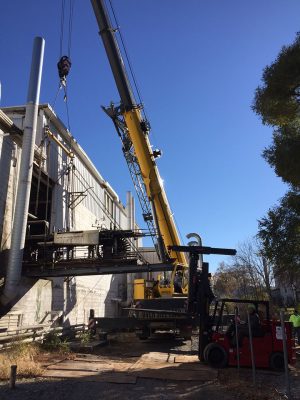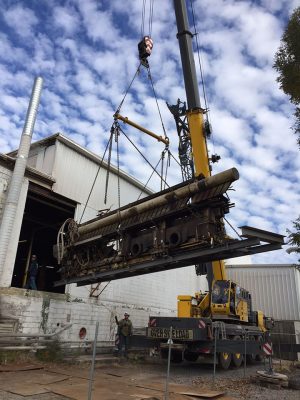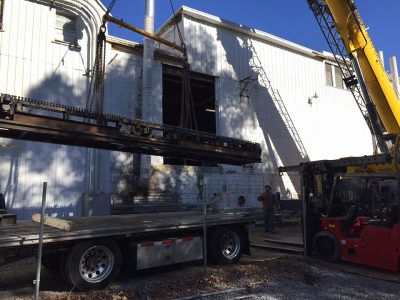In 2016, The Corning Museum of Glass was offered a donation of a large ribbon machine from OSRAM Sylvania/LEDVANCE Corp. in Wellsboro, Pa., along with a large selection of molds for the manufacture of light bulbs. Although the Museum already had a ribbon machine (an early version from the 1930s), the new machine was the most modern, largest, and fastest ever built, so CMoG decided to acquire it. The mechanization of glass making is an important part of the “story of glass” and the Museum has collected numerous machines over the years in an effort to save them from the scrapyard and preserve that part of the story.
The ribbon machine was conceived by William J. Woods in 1921, and designed in collaboration with David E. Gray. Molten glass sags through an opening to form a ribbon of glass, a part of which enters a mold; air pressure expands the glass to form an electric light bulb envelope. By moving this ribbon of glass across a sequence of orifice plates and molds, the machine produces a constant stream of bulbs, hour after hour. By 1926, a Corning Ribbon Machine could produce up to 300 light bulbs per minute; in 2016, the ribbon machine CMoG acquired could produce approximately 1,700 bulbs per minute.
Read Curator of Science and Technology Marvin Bolt’s blog post about the history of the machine and how it works.
Moving a machine of this size — approximately 60,000 pounds — is not a simple or inexpensive project. CMoG worked with the factory’s millwrights and engineers, and contracted with an outside rigging company, Atlantic Millwrights Inc., and a local shipper, Dimon & Bacorn Inc., to come up with a plan for dismantling, rigging, moving, and shipping the machine to the Museum’s offsite storage facility. The factory millwrights worked to separate the machine into four large sections (and numerous smaller pieces) and Atlantic rigged them onto large steel shipping “pallets” so the pieces could be safely moved out of the building and onto flat-bed trailers for shipment.
After weeks of preparation (including permits to close a sections of railroad tracks that run along the factory), on a cold and clear November morning the move began. Slowly, the riggers used heavy equipment to move the palleted sections — some as heavy as 23,000 pounds — into place and then out of the building. These sections were loaded onto flatbed trailers, which then made the trip to the Museum’s offsite facility, where additional heavy equipment awaited to move the piece into storage.
- Section of the Ribbon Machine being craned out of the building
- Section of the Ribbon Machine being craned out of the building
- Section of the Ribbon Machine being loaded onto a flatbed trailer for transport
Although there are no immediate plans to display the “new” ribbon machine, an important part of the Museum’s mission is to preserve artifacts, and so by acquiring this work, we are able to document, preserve and tell the “story” of this important development in glass making technology.





